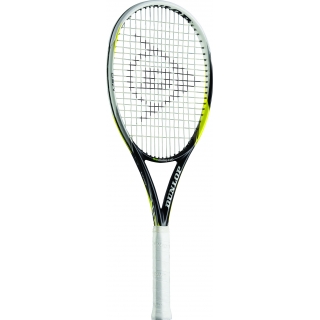Tennis Racquet Review: Dunlop Biomimetic M5.0
May 20th, 2013
I am always hesitant to speak in sweeping generalities about tennis racquets or anything else. But I have thought and believed for awhile that the racquet companies are making too many racquets; and that the controlling ‘marketing strategy’ is to just make a lot of frames and hope that some of them find a niche.
The problem is that the consumer is overwhelmed with choice, the good racquets are often hidden from sight or use inside the product flow, and that it takes a player a lot of time and effort to find a good racquet.
To my way of thinking the Dunlop Biomimetic M5.0 series of tennis racquets is everything that is wrong with the tennis racquet market today. The frame looks nice enough. It is the standard 27 inches long and weighs 10.4 ounces strung. It has a custom black and yellow finish with some of the skin dimpling which is done on all of the Dunlop Biomimetic frames (or at least on all of the ones that I have hit with). According to the Dunlop materials the racquet is slightly head light. To be truthful it felt totally balanced to me.
I was optimistic starting out. But after hitting less than ten ground strokes warming up my elbow started hurting. Or my upper forearm and elbow. I cannot express really how much I disliked this racquet. I found it difficult to control the ball. The tennis ball sailed quite a bit, and when I tried to hit with more topspin the ball dove into the other side of the court short or even into the net.
I didn’t like volleying or serving with this tennis racquet anymore than I liked hitting ground strokes. I could control my flat and slice serves fairly well, as long as I ignored my arm which was literally throbbing after about 20 minutes of play. My kick serve just turned over really fast and did not have much depth.
And any ball that I tried to hit with slice like a backhand approach shot or any first volley, really tended to sail long, albeit low and long. There is just a bad dynamic with this frame in terms of the relationship between spin and pace and outcome.
The racquet is designed for 4.0 players according to Dunlop. If I was working with a 4.0 player who was hitting flat and out a lot, I might suggest that they try this racquet. But that would be a very narrow market, if I was trying to justify the design and manufacture and marketing of a racquet like this. I have a hard time imagining exactly Dunlop was aiming for with this frame. In any case they missed, in my eyes anyways.
Mark Pinckney



